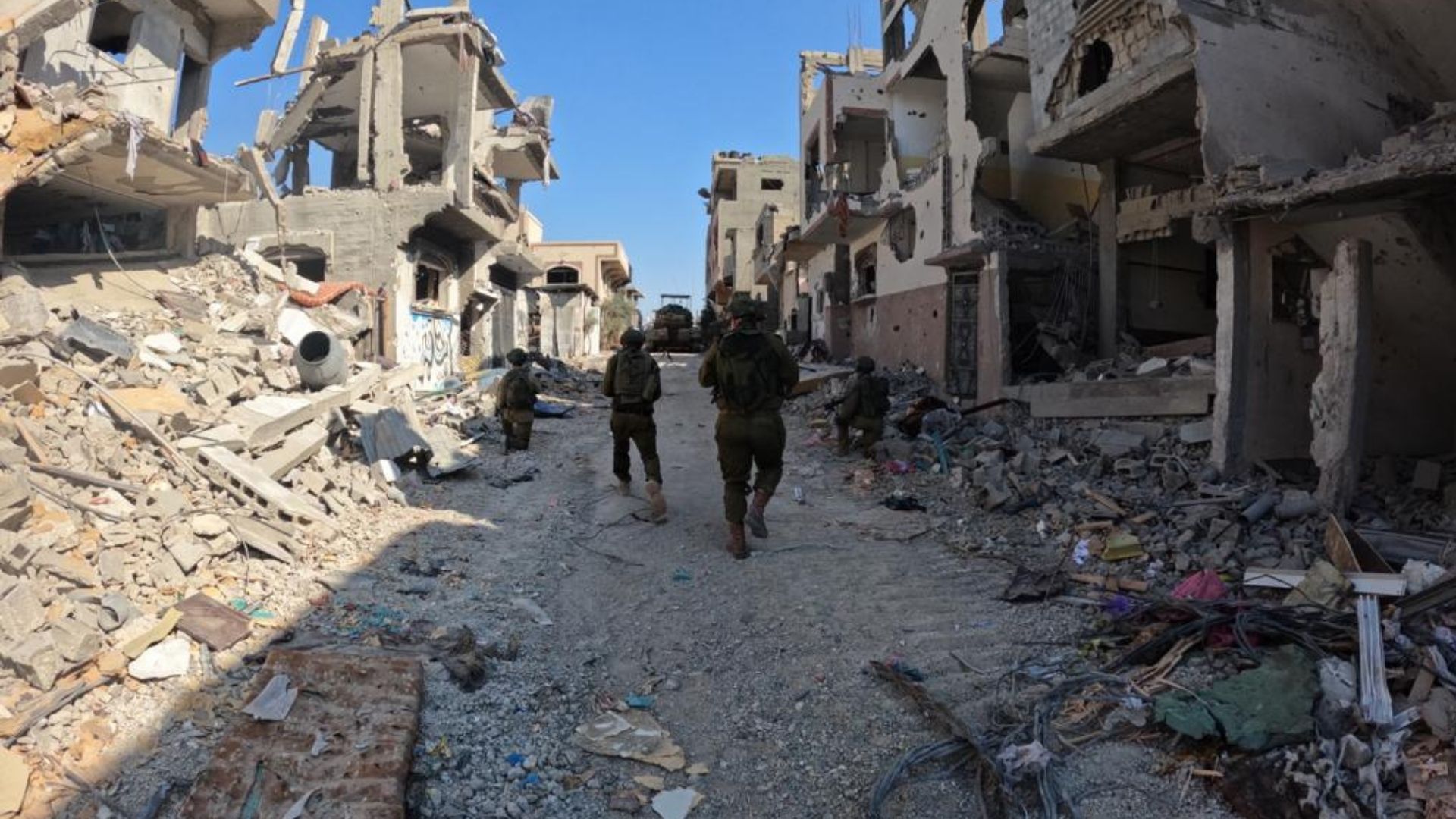This commentary, the fifth in a series on “The Polycrisis and the Global Green New Deal,” takes the war that began in Gaza and is spreading throughout the Middle East as a laboratory for dissecting the dynamics of the concatenation of crises now being referred to as the “polycrisis.”

“Swords of Iron” war, Israel-Hams war – armed conflict around the Gaza Strip that started on 7 October 2023. Photo credit: Israeli Defence Forces Spokesperson’s Unit, Wikipedia Commons.
In previous commentaries in this series we have explored the emergence and dynamics of the polycrisis. In this commentary we will see how these dynamics are playing out in the increasingly global struggle that first broke out in Palestine at the end of 2023.
Conflict in the Middle East has been endemic for a very long time. It would not take a global polycrisis to ignite a new round of war and escalation. But the global polycrisis gives the current war in the Middle East some distinctive elements, and conversely what started as the war in Gaza vividly illustrates what the polycrisis means in practice.
Backstory
European anti-Semitism, from the expulsion of the Jews from England in 1290 and from Spain in 1492 to the extermination of six million Jews by the Nazis, created a worldwide diaspora. This led many diasporic Jews to seek a national home, and a small number of pioneers began to establish settlements in the predominantly Arab territory historically known as Palestine. In World War I Britain attacked and ultimately replaced the Ottoman Empire as the ruler of Palestine. During the war Britain announced support for a “national home for the Jewish people” in Palestine. Jews were divided on how to relate to their Arab neighbors, but a Zionist movement opted to seize Arab lands and establish an Israeli state. They won support from many countries, including the US and the USSR. The establishment of the Israeli state was followed by repeated wars between Israel and its Arab neighbors, nearly all won by Israel.
In the post-World War II period the US developed a policy for de facto control of the Middle East based on the “strategic dyad” of Israel and Iran. The purpose was to maintain control of Middle Eastern oil and contain Arab nationalism and leftism. However, the Iranian revolution of 1979 turned Iran into an opponent of the US role in the Middle East. As a result, the US became dependent on Israel as its primary “reliable” ally in the Middle East, supplemented by Saudi Arabia and other conservative monarchies. The effort to restore stable US dominance in the Middle East contributed to numerous wars not only in Palestine but in Iraq, Syria, Afghanistan, and elsewhere in and near the region. With the failures of US military operations there, the US turned to an effort to stabilize relations between Israel and the Arab monarchies through a series of agreements known as the Abraham Accords, first signed in 2020.
The Hamas attack on Israel on October 7, 2023 and Israel’s subsequent attack on Gaza, initiated a dynamic that illustrates many aspects of the polycrisis. In this commentary I will focus primarily on the first few months of the conflict; while much has happened in the meantime, the dynamics visible from early days have so far persisted.
Polycrisis dynamics in the Israeli-Palestinian conflict

Palestinians transport the injured to the Indonesian Hospital in Jabalia, north of the Gaza Strip on October 9, 2023. Photo Credit: WAFA (Q2915969) in contract with a local company (APAimages), Wikipedia Commons.
While many elements of the Gaza war and its ramifying effects resemble various examples from the past, the overarching context of global polycrisis that I have described in previous commentaries gives them a different significance and portends a different result.[1]
Unpredictability The Hamas attack on Israel shows the unpredictability of events in the polycrisis. Despite their enormous espionage and surveillance resources, neither the US nor Israel nor any other state appears to have had or taken seriously advance knowledge of the devastating attack that Hamas had been preparing for months. Indeed, in a speech just a week before the Hamas attacks, US national security advisor Jake Sullivan proclaimed, “The Middle East is quieter today than it has been in decades.”[2]
“Butterfly-wing effect” The vast violence and disruption unleashed in and beyond at least half-a-dozen countries by the October 7 Hamas attack on Israel illustrates the disproportionate scale of cause and effect that characterizes the polycrisis. It would be hard to find a fitter illustration of chaos theory’s paradigm example of non-linear causation: the wind from a butterfly’s wing that at an early stage can shift the direction of a mighty storm.
Proliferation The war between Israel and Hamas in Gaza and its rapid spread to at least five countries (so far) and the Red Sea exemplify the overall proliferation of war in the era of polycrisis. Further, the conflict polarized and mobilized a dozen other nations and armed groups for war. As the Guardian synopsized the early stages of this process:
Within hours of the outbreak of the Gaza war, the Hezbollah Shia militia in Lebanon began to fire on northern Israeli towns and villages in solidarity with Palestinians, triggering Israeli air strikes in response, and Houthi forces in Yemen attacked ships in the Red Sea with real or perceived Israeli connections.
At the same time the West Bank erupted in protests at the bombing of civilians in Gaza and extremist Jewish settlers quickly sought to ride the wave of Israeli anger by seizing Palestinian land and terrorizing its residents.
Each of these theatres of conflict has the potential to ignite a much-feared Middle East conflagration, and the past few days have demonstrated just how easily escalation, intended or not, could bring Israel into open confrontation with Iran and suck in the US too.
The US moved two aircraft carriers and their accompanying strike groups to the region as American bases in Syria and Iraq came under repeated attacks from Iran-affiliated groups, drawing swift retaliation from Washington.
Tehran’s Houthi allies have meanwhile been firing on the US-led “Prosperity Guardian” naval task force assembled to protect shipping in the Red Sea. American warships shot down dozens of drones and also a handful of ballistic missiles. US Central Command issued a statement to say that Washington had “every reason to believe that these attacks, while launched by the Houthis in Yemen, are fully enabled by Iran.[3]
Escalation Tit-for-tat escalation illustrates the polycrisis dynamic of a “systemic self-amplifying feedback loop,” aka a vicious circle. Mohamed Khaled Khiari, a UN assistant secretary-general, told security council members that, while most of the exchange of fire between Israel and Hezbollah had been around the border, some strikes were going deeper into each other’s territory, “raising the spectre of an uncontained conflict with devastating consequences for the people of both countries.” Khiari added that “the risk of miscalculation and further escalation is increasing as the conflict in Gaza continues.”[4] A similar dynamic is manifested in the escalating conflict between the US and various non-state groups it alleges are proxies for Iran.
Glocalism As discussed in a previous Commentary, a characteristic of the polycrisis is the intertwining of local non-state actors with international power centers. The wars now touching at least five countries in the Middle East show the interpenetration of local non-state actors and international power politics.
Limits of US hegemony The ability of the US to supply the weapons and diplomatic support that are essential to Israel’s genocide in Gaza shows the continuing power of the US; but the inability of the US to effectively control the other players in the Middle East shows the change from the unipolar era. The US relation to Israel in particular shows how little even the greatest remaining great power is able to impose its own interests, even on those who are supposedly its allies. While in the past the US has from time to time successfully pressured Israel to back off from its military actions, in this case the tail so far is wagging the dog. The limits of US hegemony are also indicated by its inability to shape world opinion, the International Criminal Court, the International Court of Justice, or the UN General Assembly, and its isolation within the UN Security Council. The US has become both the greatest of the world’s Great Powers, and, in the memorable phrase of Spiro T. Agnew, a “helpless, pitiful giant.”
Neither unipolar nor bipolar The dynamics of the Gaza war exhibit neither the bipolar character of the Cold War nor the US hegemony of the “unipolar moment.” While the US role so far is quite consistent, the role of the other great powers is ambiguous. The supposedly overarching geopolitical antagonism between the US and China is so far a relatively minor factor – even though China has been mediating between Palestinian factions, the US has gone so far as to politely ask China to intercede with Iran on its behalf. The future may well see a great power polarization around the Middle Eastern war, but at the moment Great Power rivalry is subordinated to other factors.
Post-colonial disunity The so-called “West,” defined as the European colonial powers and white settler colonial states, initially functioned as a bloc, lining up with Israel. Over time, especially with Israel’s genocidal action in Gaza, this unity has become progressively less solid. According to commentator Eldar Mamedov, EU-NATO countries are “entirely split over Israel, Iran, and Houthis.” There is “no sign so far that the EU is gearing up to join the U.S. conflict with the Iran-backed forces in Syria and Iraq, either militarily or through diplomatic support.”[5]
Breakdown of peacemaking The inability of the UN to impose a ceasefire, despite the overwhelming international support for such a move, is an example of the general breakdown of peacemaking capacity in the polycrisis era.
Breakdown of norms and moral limits The initial Hamas attack on Israel and the rapid development of what is undoubtedly the most visible genocide in world history on the part of Israel illustrate the general breakdown of international norms and any sense of moral or human rights limits on state action. The United Nations Office for the Coordination of Humanitarian Affairs says that the situation in the Middle East had probably “never been worse” since it began collating records in 1991. Jeff Feltman, a senior fellow at the UN Foundation, says: “The combination of humanitarian crises across the Middle East – including the humanitarian catastrophe in Gaza – have put more strains than most of us have ever seen on the financial ability of donors to respond and the ability of humanitarian actors to meet the needs.” Jens Laerke, a senior official at OCHA, says, “Despite 70 years of international efforts to solve problems by diplomacy and by non-violent means, leaders around the world are now reaching for the gun to resolve their differences as a first option. The question is: are we entering an age of war?” As one journalist put it, such actions reveal “a collective erosion of self-restraint and the rule of law.”[6]
Cascading consequences Houthi attacks on shipping in the Red Sea illustrate the way in which consequences cascade across different sectors of the world order in the era of polycrisis. The attacks sharply impeded world transit and trade, as shipping companies rerouted their vessels via circuitous, expensive routes. The volume of traffic moving through the Red Sea’s Bab al-Mandab strait was cut in half.[7] The trade impact was particularly strong in vulnerable countries like Egypt.
The Houthi attacks, unsurprisingly, led to internal pressures in the US to retaliate, even at risk of provoking a wider war, including the possibility of a US war with Iran. US warships were sent into the Red Sea, ostensibly to protect against Houthi attacks. Iran in turn sent warships into the Red Sea. US attacks on Houthi and other alleged “Iran surrogates” led to a breakdown of the Yemen peace process. As Guardian columnist Nesrine Malik put it,
All of this is happening in a wider context of crises and divisions in individual countries. Each escalation results in a rippling series of repercussions. Houthi attacks in the Red Sea have diverted commercial traffic headed to North America and Europe away from the waterway, affecting Egypt’s much-needed revenues from the Suez canal and potentially the country’s stability in the middle of a prolonged financial crisis.[8]
Nascent rise of the nonaligned Overwhelming votes in the UN General Assembly, and the isolation of Israel and the US, even in the Security Council, point to the possible emergence of a non-aligned global coalition that could potentially challenge international crimes and the struggle for great power hegemony. However, the inability of this potential “great power” to even slow down the genocide in Gaza also illustrates that it is not yet able to exercise significant power.
As the Israeli attack on Gaza continued month after month, the genocide death count grew steadily higher. Tit-for-tat escalation between Israel and Hezbollah made full-scale war increasingly likely. In mid-June, when Hezbollah released a drone video of potential targets in northern Israel, Israeli officials warned of “an all-out war” in which Hezbollah will be destroyed and Lebanon would be sent “back to the Stone Age.” Hezbollah leader Hassan Nasrallah thereupon threatened a war with “no restraint and no rules and no ceilings.”[9] In late June Iran’s mission to the United Nations warned that if Israel embarks on a “full-scale military aggression” in Lebanon, “an obliterating war will ensue” and that in such an event, “all options, including the full involvement of all resistance fronts, are on the table.”[10] Even if the various parties agree to a ceasefire, it is less likely to be a step toward peace than primarily a means to acquire military and political advantage before the next round of war and genocide.
The events triggered by the October 7 Hamas attack on Israel show the irrationality, unpredictability, uncontrollability, and folly that human actions have acquired in the era of the polycrisis. While events are unpredictable, the dynamics of the polycrisis have made it substantially less likely that this story will have a happy or even bearable outcome.
[1] I deal here only with the military and geopolitical aspects of such interaction. The economic, governance, environmental, and other aspects will be dealt with in later commentaries.
[2] Nesrine Malik, “Fears are rising of ‘regional escalation’ in the Middle East. But that wider war is already here,” The Guardian, January 8, 2024. https://www.theguardian.com/commentisfree/2024/jan/08/israel-gaza-middle-east-escalation
[3] Julian Borger, “Middle East is sliding closer to the edge of a wider regional conflict,” The Guardian, December 31, 2023. https://www.theguardian.com/world/2023/dec/31/middle-east-sliding-closer-wider-regional-conflict-israel-iran-us
[4] Ibid.
[5] Eldar Mamedov, “EU-NATO Countries Entirely Split over Israel, Iran, and Houthis,” Responsible Statecraft, February 7, 2024. https://responsiblestatecraft.org/houthis-europe-eu/
[6] Mark Townsend, “Middle East thrust into ‘apocalyptic’ humanitarian crisis by war and turmoil,” The Guardian, January 22, 2024. https://www.theguardian.com/global-development/2024/jan/22/middle-east-apocalyptic-humanitarian-crisis-war-humanitarian-aid-israel-gaza-yemen; and Patrick Wintour, “Seemingly disparate Middle East conflicts show collective erosion of self-restraint,” January 20, 2024. https://www.theguardian.com/world/2024/jan/20/seemingly-disparate-middle-east-conflicts-show-collective-erosion-of-self-restraint
[7] Atticus Canham-Clyne, “Hamas’s allies expose limits and liabilities of US power,” Responsible Statecraft, February 7, 2024. https://responsiblestatecraft.org/us-hamas-middle-east/
[8] Nesrine Malik, Ibid. https://www.theguardian.com/commentisfree/2024/jan/08/israel-gaza-middle-east-escalation
[9] Khaled Elgindy, “Biden’s mixed messages to Israel are coming home too roost,” Responsible Statecraft, July 2, 2024. https://responsiblestatecraft.org/biden-netanyahu-israel-lebanon/
[10] Tom Ambrose, “Middle East crisis: Iran sounds warning on Israel ‘aggression’ in Lebanon – as it happened,” The Guardian, June 29, 2024, https://www.theguardian.com/world/live/2024/jun/29/israel-gaza-war-middle-east-iran-lebanon-hamas

